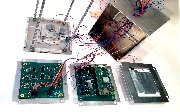MAI is completing the development of the unique spacecraft attitude control system
“The solution to the first problem was proposed long ago", says one of the project participants, assistant of department 601, candidate of technical sciences, Evgeny Chebakov. "Nowadays, various sensors are being manufactured to determine the heat flux, but their application at spacecraft is difficult for various reasons. For example, some of them are not designed to operate in the space environment, while others are complex in design, large in size, and heavyweight. Besides, there are other requirements to the sensors: they must determine the heat flux in dynamics, must be isolated from the devices and structural elements of the spacecraft, etc. So the technical part of the problem had to be solved practically from scratch”.At the early stages of the project the team developed a software package for solving the first and second inverse problems, the prototypes of the sensors were created, and several preliminary thermal tests were carried out. After that, the prototypes, together with the system for collecting and processing telemetry, were tested in a thermal vacuum chamber at department 208 "Electric rocket engines, power, and energy-physical installations". According to the test results, the most efficient sensor prototype basing on a thin copper plate was selected.
“At the end of last year we conducted thermal vacuum tests of the sensor together with a new system for collecting and processing telemetry, which will solve two inverse problems”, says the young scientist. “It consists of telemetry acquisition board developed by our team and a Raspberry Pi Zero microprocessor”.The Advantages of the SystemToday systems of two main types are used to determine the attitude of a spacecraft: optical (solar and star sensors, infrared vertical) and magnetic (magnetometers). Inertial sensors are also used, but over time they accumulate errors, so they should only work in conjunction with optical or magnetic ones.All of these systems have their advantages and disadvantages. For example, a spacecraft with optical sensors takes time to target them to the object – the Sun, or a planet – or match the current position with a star map. Optical sensors have the highest accuracy, but their matrix is exposed to radiation, which affects reliability. The solar sensors and the infrared vertical complement each other, since separately they cannot determine the angle of rotation relative to the target object. Also, solar sensors do not work in the shadow of the planet, and the infrared vertical and magnetometers do not work far away from the planet.
“The sensors used in our attitude system consist of a thin metal plate, a thermo-optical coating on the irradiated surface, and a thermocouple on the backside”, explains Evgeny Chebakov. “The design is simple, so there is simply nothing that might break down in it. The reliability of the system we are developing is comparable to that of magnetometers. Moreover, it can be used both in the shadow of the planet and during interplanetary flights. One sensor will only weigh a few grams, and the system itself will not require a lot of power. At the same time, the time to determine the orientation is minimal, on average about 3-5 seconds to start the algorithm and then less than a second”.The main disadvantage of the method is its relatively low accuracy: the error can be from 1 to 8 degrees. Nevertheless, the system might be used for preliminary orientation with the subsequent use of more accurate sensors, or serve as the main one on the spacecraft for which such an error is not critical.
“Engineers combine different sensors to minimize individual drawbacks. Our approach may complement the existing methods, increase the efficiency of orientation and, of course, increase the reliability”, the researcher notes.To the OrbitAt the next stage of work, the research team plans to conduct flight tests of the system. It is planned to launch the MAI CubeSat satellite, equipped with an experimental system based on six sensors, from the ISS.
“If everything goes well, then the next CubeSats will be created based on the design of this satellite, including maneuvering ones”, claims Sergey Firsyuk, head of MAI student design bureau Iskra.It was originally planned to launch the satellite this spring, but the pandemic changed scientists' plans and the satellite's development schedule. In the near future, it is planned to carry out additional thermal vacuum tests of the assembled system, as well as tests of the satellite with the system, based on their results the issue of the timing of the next stage will be settled.MAI experts are confident that the new system will be of interest to the organizations involved in the development of small spacecraft. It is assumed that large manufacturers interested in increasing the reliability of their products and extending their active life will pay attention to it since the system might be installed to large spacecraft with a complex configuration as an additional or backup. After finalizing the existing mathematical model, the method might be used for interplanetary flights. Additionally, the creators have already outlined the way to improve the method to increase its accuracy, so it is possible that soon the development will take a significant share in the market of spacecraft attitude control systems.

